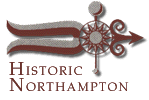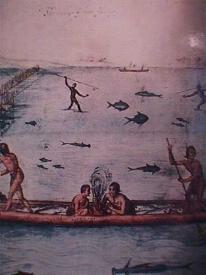

|


Native American Peoples I

The first peoples to inhabit the Connecticut River Valley were the Paleo Indians, whose ancestors had migrated from Asia 12,000 years ago during the Pliesticiene era. These nomadic hunters followed the mastodons and mammoths that began to inhabit the tundra-like landscape that characterized the Valley as the ice cap retreated northward. Paleo Indians fashioned planopoints - projectile points made of stone- fitted with a notched spear shaft. As the mammoths and mastodons became extinct, and the caribou herds migrated to Canada, many of the Paleo Indians followed.
As the climate warmed, forests began to appear in southern New England, and with them,. the white-tailed deer. Unlike caribou, white-tailed deer are not herd animals. They required different hunting techniques which, in turn, fostered new forms of social organization among those who hunted them. About 10,000 years ago, the Early Archaic Indians migrated here from the West and replaced their northward-moving predecessors. Primarily hunters, these people also worked wood with stone axes and bone tools. Two thousand years later, the Middle Archaic Indians perfected a spear-launching device called an atlatl- a throwing stick weighted with a drilled, oval stone. They also used ulus - semi- circular stone knives used to scrape and clean animal skins. During the Late Archaic period (5,000 years ago) the climate warmed and growing seasons became longer. Population increased and became less mobile. Nucleated families made up settled communities of birchbark wigwams. Fishing intensified, using canoes, fishing weirs and weighted nets. Soapstone (steatite) was quarried and shaped into heavy bowls used for cooking vessels.
The Early Woodland period began about 3,000 years ago with the introduction of ceramic technology into New England from the South and West. Pottery became increasingly decorative as did personal artifacts such as gorges or pendants worn around the neck. Small circular wigwams seemed to give way to larger, longer house structures. Beginning about 1,200 years ago, the Late Woodland period was characterized by the introduction of maize horticulture. New England horticulture was not land or labor intensive and was characterized regionally by corn mound planting practices. It was during this period that arrowhead projectile points proliferated. By the time of the Contact Period, Native peoples along most of the Atlantic seaboard spoke local variations of a common language called Algonquin. Wide trade networks existed. Trade goods included mica, red ochre, pottery and ceremonial pipes. Important places on the landscape, such as traditional fishing sites and sacred places were marked and remembered by each generation.
The Indians' religious beliefs envisioned the universe as highly animated, with spiritual power-manitou- dwelling in people, animals, plants and objects. Their religious ceremonies were linked to seasonal activities, such as the hunt and the harvest, and to stages of life, like the passage from childhood to adulthood and from life to death. When ordinary ceremonies proved insufficient, Indians called upon pow-wows, special individuals who could intervene with Hobbamock, the fearsome deity who caused such disorders as extreme weather and severe illness. The major source of manitou for southern New England Indians was Kiehtan, or Cautantowwit, who was believed to be the source of corn and to reside in a great house in the southwest. Indians believed that when they died, they went to Kiehtan's house to dwell forever.
Indian communities were based on principles of equality. Families that were successful in hunting or farming in a given year shared some of their surplus with those who had less. Political leaders, or sachems, were spokesmen or spokeswomen for their communities. Although they usually came from leading families, they would be replaced if they failed to perform satisfactorily.
Contents Historic Northampton.